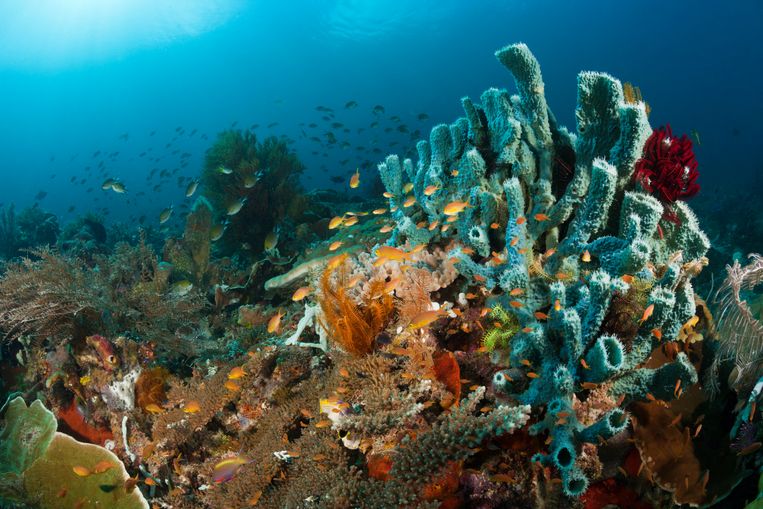The coral reef on Curacao
What makes the coral so bustling with life (while the water is so nutrient-poor)
Coral reefs are full of life, while they are surrounded by nutrient-poor water. An international research team believes they have solved Darwin’s paradox.

Charles Darwin already wrestled with it: how is it that coral reefs in the tropics are teeming with life when they are surrounded by oceans with little food? How can the richness of these ecosystems be explained? Researchers say they have brought a solution to this riddle, known in scientific circles as Darwin’s paradox, closer.
In the clear, nutrient-poor waters of tropical seas, coral reefs are like desert oases. In a poor environment, they are home to an enormous variety of life forms, from the tiniest organisms to the most colorful fish species. An international research team recently presented a new theory about these biological hotspots in Science.
According to the scientists, the solution to Darwin’s paradox must be sought in the many small fish that live near a coral reef on the seabed. They are an important food source for larger fish and thus serve as fuel for life on a reef. “Those fish are candy,” explains lead researcher Simon Brandl of Simon Fraser University in Canada. “Small packets of energy that are eaten almost immediately by all other animals that can bite, grab or slurp.”
Base fixed fish
It concerns many types of fish of at most a few centimeters. The larvae of these species – unlike most fish larvae – do not allow themselves to be carried away into the ocean, but stay close to home. The base fish reproduce at lightning speed, their larvae grow quickly and they are also eaten quickly – usually in the first weeks of their existence.
The mini-fish provide nearly 60 percent of all fish consumed around reefs by larger fish. Their “hidden productivity” makes them a cornerstone of coral reef functioning, the authors write. The fact that scientists have previously overlooked the role of these critters is because they are eaten so quickly, Brandl says. “They are eaten before you can count them.”
Sponge poo
Jasper de Goeij, assistant professor of tropical marine biology at the University of Amsterdam, thinks it is a ‘nice addition’ to other theories, but does not consider the study in Science as the ultimate explanation for the rich biodiversity on coral reefs. Small fish are not the whole story. Together with colleagues, he did research in Curaçao and there he discovered that sponges are an indispensable link in the food supply on coral reefs. Sponges, which cover the inside of crevices and cavities in a coral reef, filter bacteria, unicellular algae and dissolved substances, such as sugars, from the seawater and convert them into waste. The sponge poo serves as food for crabs, worms and snails, among other things. These are in turn eaten by larger animals.
Sponges are undervalued organisms, says De Goeij. “They are very important for the energy cycle. The greatest source of potential food is dissolved in the water and they use it extremely efficiently. They quickly renew their cells and excrete old cells as dead organic material. They fertilize the reef, as it were.’
Fleur van Duyl, researcher at the Royal Netherlands Institute for Sea Research (NIOZ), finds it striking that the small fish with their large offspring are such an important food source. Yet she is not convinced that they are solely responsible for the biological wealth on a reef. It is crucial, she says, that corals and the organisms that live on them are very efficient at capturing the scarce nutrients. It is this characteristic that gives a coral reef its unique vitality.
Van Duyl: ‘Corals remove dissolved substances and a little plankton from the water flowing past and supply the algae with which they live in symbiosis with nitrogen and phosphate. The corals then receive energy and building materials from the algae, which have made this with the help of photosynthesis. There are reefs where corals thrive, while there is almost nothing in the water. It starts with corals and gradually the ecosystem becomes richer in food and species of organisms.”
Food pyramid
The richness of a coral reef is not mainly due to mini-fish, responds Erik Meesters, coral ecologist at Wageningen Marine Research. He puts the importance of the fish larvae into perspective. ‘They make up a very small part of all the plankton. The great biodiversity on reefs is more related to the nutrients that rise in coral reefs from deeper, cold water layers, which gives you a lot of plankton there. Increased plankton production strengthens the first layer in the food chain. This is where the foundation is laid for the ecosystem. Fish are higher in the food pyramid.”
Has Darwin’s paradox now been resolved? As far as Masters are concerned, the riddle is no longer a riddle. ‘We are getting a better understanding of the processes on a reef. Brandl et al.’s research goes one step further. It shows once again that energy and carbon, the basis of all life, are well reused on a coral reef.”
There is no longer a mystery for Van Duyl either. “We know that several factors contribute to the ability of an ecosystem to be so rich in a poor environment. We just don’t know yet how great the contribution is of each individual component.’ According to De Goeij, the mystery has largely been solved with the observation that organisms on a coral reef know how to make clever use of substances dissolved in water. And that they recycle the nutrients efficiently. “Like reusing a peanut butter sandwich a hundred times.”
source: Volkskrant
You can visit our Facebook and Instagram pages to have a look at our latest listings.
Categorieën: News
Tags: coral Curacao, diving Curacao, reef Curacao, sea bottom Curacao
